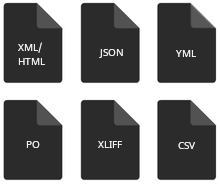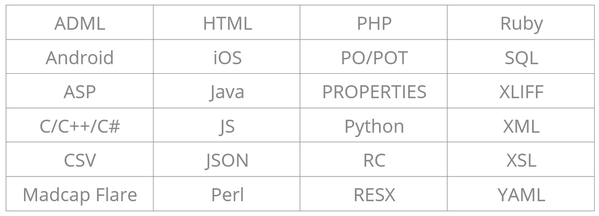|
Software/App
Localization Software/app localization (or L10N) is the process of adapting a software product to different languages, regional differences, and technical requirements of a target market. A typical localization adapts the user interface (UI), the associated documentation, and the online help. We can assist you in this process for a variety of formats including the following: |
Zab can localize the following software file types (and many more, including custom formats):
|
Are you localizing your web or mobile apps? If not, the following are some compelling reasons why you might want to.
|
Where should you start? Spanish is always a great place to start due to the high number of Spanish speakers inside and outside the U.S.
You should also put Chinese on your shortlist. Not only is there a large population of Chinese speakers inside the US, there's also a “U.S.-sized population of high-income, educated users who could become customers in China,” says Phil Libin, former CEO of Evernote Corp. |
Best practices of software localization. The following items should be kept in mind when developing your product to simplify the software engineering process and to provide an optimal experience for your international users:
We also offer support with the following key steps in the localization process:
- Text strings should never be embedded in the software code. Instead, code your software in an environment that allows strings to be separated into resource files.
- Unique strings are best suited for localization. Avoid using concatenated text strings, as it is very difficult to keep the meaning in context once they are translated into other languages.
- Language support. Country, region, and language selections should be easily accessible to a user.
- Encoding support. Ensure that your software supports Unicode/UTF-8 resource files and is able to display Unicode text in your UI. This allows your software to display any potential language.
- Internationalization (i18n) support. Date, time, measurement, address, currency, and other formats should match a user's country, region, and language preferences.
- Language expansion. Most languages are 20%-30% longer than English. UI text-based elements should be oversized or dynamically resized to account for text expansion in other languages. A good responsive design can assist in this effort.
- Translate and test software UI strings first. Doing this prior to translating the associated documentation and help allows you to establish terminology, make modifications in the software, familiarize the translators with the localized product, and create consistency without having to repeat these changes in the documentation and help.
We also offer support with the following key steps in the localization process:
- Cultural adaptation. The software should take foreign audiences into consideration and should be adapted accordingly, which may include pictures, symbols, messages, layout, colors used, or other cultural nuances.
- Syntax validation. Validation of the encoding and syntax for all resource files to ensure your developers can build the localized software hassle-free.
- User interface testing. Adjustments to the interface may need to be made due to text expansion or cultural preferences, which may require resizing of dialog boxes, buttons, etc.
- Linguistic testing and functional testing. Includes review for correctly displayed fonts, translation in context, character encoding, sorting, keyboard shortcuts, and internationalization functionality.
- Localization planning and engineering. While translating existing text to other languages may seem easy, it is difficult to maintain parallel versions of a product. If you are planning for a simultaneous release of your product in multiple languages, coordination with Zab should take place early in the development process. Whether you develop under Agile or Waterfall methodologies, we will create a localization schedule and evaluate any potential cultural, technical, or linguistic items that might represent obstacles in the process.
Contact us ▶ to discuss your next software localization project.





